Related Research Articles

Carnival or Shrovetide is a Christian festive season that occurs before Lent, consisting of Quinquagesima or Shrove Sunday, Shrove Monday, and Shrove Tuesday or Mardi Gras.

San Pedro is a town on the southern part of the island of Ambergris Caye in the Belize District of the nation of Belize, in Central America. According to the 2015 mid-year estimates, the town has a population of about 16,444. It is the second-largest town in the Belize District and largest in the Belize Rural South constituency. The once sleepy fishing village was granted the status of a town in 1984.

Ambergris Caye, is the largest island of Belize, located northeast of the country's mainland, in the Caribbean Sea. It is about 40 kilometres (25 mi) long from north to south, and about 1.6 kilometres (1 mi) wide. Many parts of the island have been modified by human development since the arrival of coconut plantations in the 17th century, but it remains largely white coral sand with mangrove forest at its center. Its eastern coast runs parallel to the northernmost stretch of the Belize Barrier Reef, a UNESCO World Heritage Site.

A comparsa is a group of singers, musicians and dancers that take part in carnivals and other festivities in Spain and Latin America. Its precise meaning depends on the specific regional celebration. The most famous comparsas are those that participate in the Carnival of Santiago de Cuba and Carnaval de Barranquilla in Colombia. In Brazil, comparsas are called carnival blocks, as those seen in the Carnival of Rio de Janeiro and other Brazilian carnivals. In the US, especially at the New Orleans Mardi Gras, comparsas are called krewes, which include floats.

Fat Thursday is a Christian tradition in some countries marking the last Thursday before Lent and is associated with the celebration of Carnival. Because Lent is a time of fasting, the days leading up to Ash Wednesday provide the last opportunity for feasting until Easter. Traditionally it is a day dedicated to eating, when people meet in their homes or cafés with their friends and relatives and eat large quantities of sweets, cakes and other meals usually not eaten during Lent. Among the most popular all-national dishes served on that day are pączki in Poland or Berliners, fist-sized donuts filled with rose hip jam, and angel wings (faworki), puff pastry fingers served with powdered sugar.

Bogotá's Carnival or Carnival of Bogotá is celebrated in Bogotá every year on August 5 and August 6 for the city's anniversary of its Hispanic foundation. Most of the cultural events take place in the heart of Parque Metropolitano Simón Bolívar The festivities also include pre-carnival celebrations during the month of July. One of the main objectives of the carnival is to promote and encourage the cultural and musical diversity of Colombia.

Blacks and Whites' Carnival, is the largest and most important festival in southern Colombia. Although its geographical location belongs to the city of Pasto, it has been adopted by other municipalities in Nariño and southwestern Colombia. It is celebrated every year in 2–7 January and attracts a considerable number of Colombian and foreign tourists.

The Barranquilla Carnival is one of Colombia's most important folkloric celebrations, and one of the biggest carnivals in the world. The carnival has traditions that date back to the 19th century. Four days before Lent, Barranquilla decks itself out to receive national and foreign tourists to join together with the city's inhabitants to enjoy four days of intense festivities. During the carnival, Barranquilla's normal activities are put aside as the city gets busy with street dances, musical and masquerade parades. The Carnival Of Barranquilla includes dances such as the Spanish paleo, African Congo, and indigenous mice y mica's. Many styles of Colombian music are also performed, most prominently cumbia, and instruments include drums and wind ensembles. The Carnival of Barranquilla was proclaimed a Cultural Masterpiece of the Nation by Colombia's National Congress in 2002. Also the UNESCO, in Paris on November 7, 2003, declared it one of the Masterpieces of the Oral and Intangible Heritage of Humanity, and it was during Olga Lucia Rodriquez Carnival Queen year.

The carnival in Colombia was introduced by the Spaniards. The Colombian carnival has incorporated elements from European culture, and has managed to syncretise, or re-interpret, traditions that belonged to the African and Amerindian cultures of Colombia. There is documentary evidence that the carnival existed in Colombia in the 17th century and had already caused concern to the colonial authorities, who censored the celebrations, especially in the main centers of power such as Cartagena, Bogotá and Popayán. The carnival, therefore, continued its evolution and re-interpretation in the small and at that time unimportant towns where celebrations did not offend the ruling elites. The result was the uninterrupted celebration of carnival festivals in Barranquilla, and other villages along the lower Magdalena River in northern Colombia, and in Pasto, Nariño in the south of the country. In modern times, there have been attempts to introduce the carnival in the capital, Bogotá, in the early 20th century, but it has always failed to gain the approval of authorities. The Bogotá Carnival has had to wait until the 21st century to be resurrected, this time, by the authorities of the city. Colombia is recognized by its large variety of festivals, carnivals and fairs. Most towns have their own, ranging from those celebrating coffee to the ones held in honor of the town's Saint feast. The common characteristics of the festivals are the nomination of a beauty Queen and the setting up of public dance floor.

The Carnival of Cádiz is one of the best-known carnivals in Spain. Its main characteristic is humor. Through sarcasm, mockery and irony, the main groups and the people of the street "purge" the most pressing problems of today. The whole city participates in the carnival for more than two weeks each year, and the presence of this fiesta is almost constant in the city because of the recitals and contests held throughout the year.
Carnivals, known as carnavales, charangas, or parrandas, have been vibrant public celebrations in Cuba since at least the 17th century, with the Carnaval of Santiago de Cuba holding a special place among Cubans.
Angela Gegg is a Belizean artist, author, entertainer, and real estate expert.

The Carnival of Santa Cruz de Tenerife is held each February–March –depending on the year– in Santa Cruz de Tenerife, the capital of the largest island of the Canary Islands, Spain and attracts people from all over the world.

The Carnival of Madeira is an annual festival held forty days before Easter, that ends on Fat Tuesday the day before Ash Wednesday. On certain days of Lent, Roman Catholics traditionally abstained from the consumption of meat and poultry, hence the term "carnival," from carnelevare, "to remove meat."

The Carnival in the Dominican Republic is a Dominican celebration that takes place throughout February, and sometimes during Holy Week in March. Dominican Carnival is celebrated in most cities and towns in the main streets. The carnival season in the Dominican Republic kicks off with a carnival gala held indoors in Santiago de los Caballeros, as opposed to every other carnival event held outdoors throughout the month of February. Among its main characteristics are its flashy costumes and loud music. The one held in La Vega, which is one of the biggest in the country, and the national parade in Santo Domingo, were the first Carnivals held in the Americas.
Haitian Carnival is a celebration held over several weeks each year leading up to Mardi Gras. Haitian Defile Kanaval is the Haitian Creole name of the main annual Mardi Gras carnival held in Port-au-Prince, Haiti.
Carnival in Mexico is celebrated by about 225 communities in various ways, with the largest and best known modern celebrations occurring in Mazatlán and the city of Veracruz.

Carnival in Uruguay is a festival that takes place every year in Uruguay from mid January to late February. The Carnival draws root from candombe, Murga and tablados, which are forms of expression of Uruguayan culture through dance and music. From its conception, the Uruguayan Carnival has evolved into a dance parade in which different comparsas, groups of street performers in Latin American festivals, play the drums and dance at the "Desfile Inaugural del Carnaval" and "Desfile de Llamadas" parade. The biggest carnival celebrations are in the capital Montevideo and can last up to 40 days. They involve a series of cultural events such as dance parades in the streets, street stages called "tablados" and an artistic contest in the "Teatro de Verano" in Montevideo.

Rosita Baltazar was a Belizean choreographer, dancer, dance instructor and founding assistant director of the Belize National Dance Company. In 2004, she was awarded the Lord Rhaburn Music Award as a dance ambassador and in 2009 she received the Chatoyer Recognition Award from the National Garifuna Council of Belize for her efforts at preserving Garifuna culture.
References
- ↑ "All is set for the Carnaval Celebrations - The San Pedro Sun News". 3 February 2016.
- ↑ "Festivities". Archived from the original on 2013-09-22. Retrieved 2016-10-04.
- ↑ "Ambergris Today - 25 Years Ago - How San Pedro Carnabal Tradition went from Powder to Paint".
- ↑ "Great Names in Carnival , 25 Years Ago, History of San Pedro, Ambergris Caye, Belize".